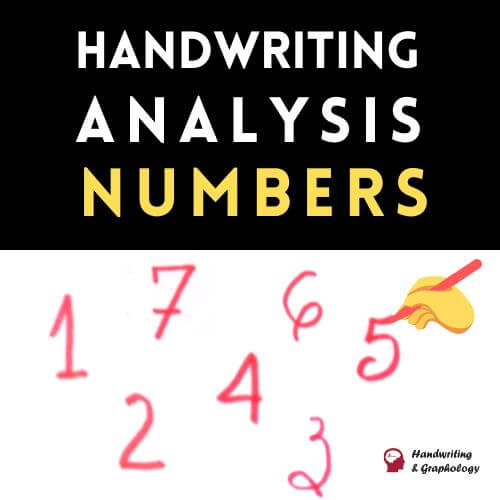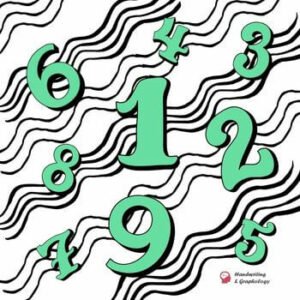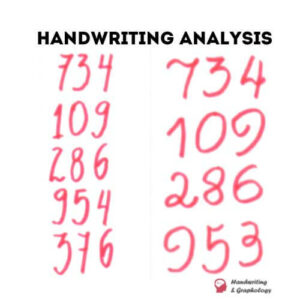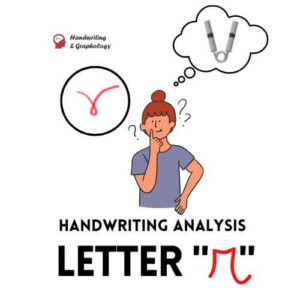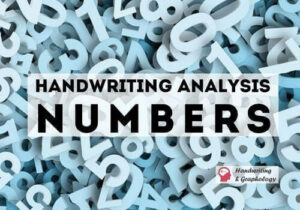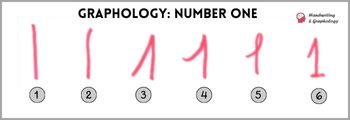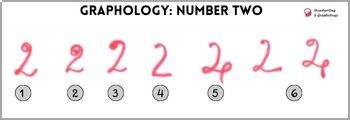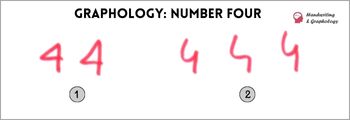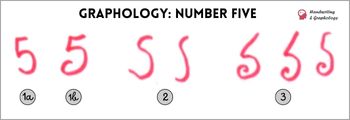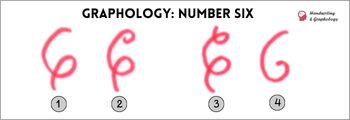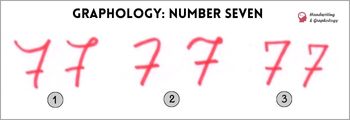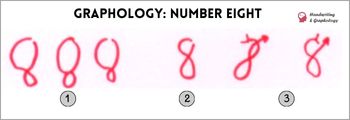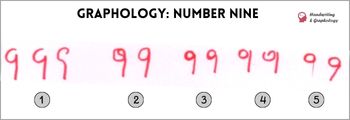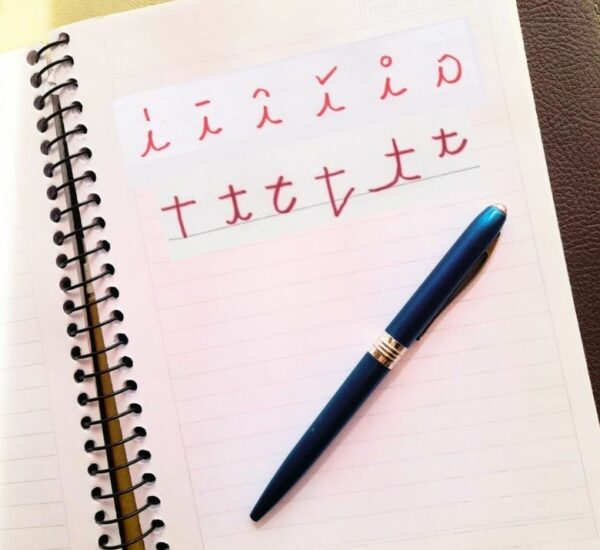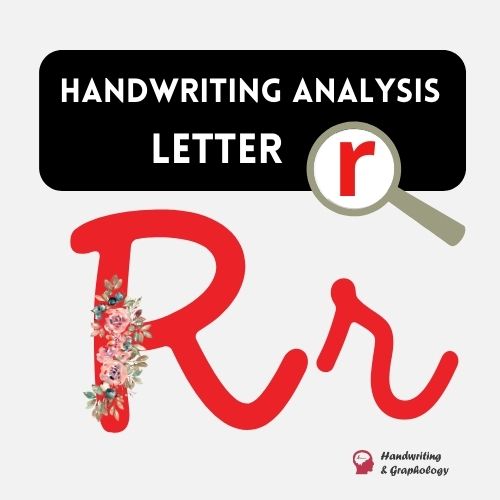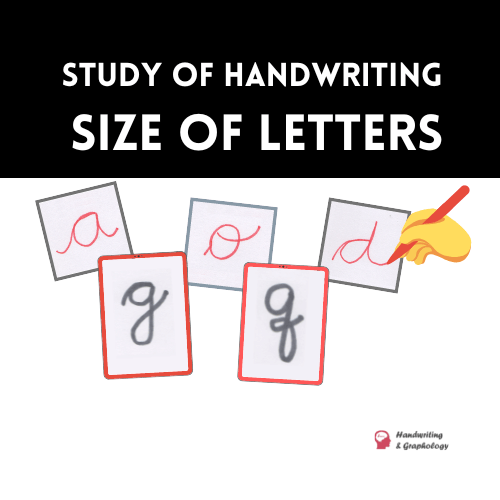Numbers are analyzed in the same way as letters: It’s important to analyze their size, slant, shape, speed, pressure, cohesion, lines, and legibility. Proper analysis always considers the entire graphical environment; a single trait does not determine personality! Remember: the numbers should also be compared with the writer’s signature and text.
Materials needed to analyze numbers:
• On a blank sheet of paper without lines, write numbers and simple mathematical operations in columns (additions and subtractions).
• A written piece of text and signature.
What do the Numbers represent in Graphology? What are they used for?
The numbers represent the relationship with the concrete world: The material, the financial and the economic.
Number Analysis is used in:
• Selection process for hiring employees: to detect a good mediator, persuasiveness, diplomatic skills, material and practical interests.
• Vocational orientation: to detect financial and commercial aptitudes in students.
• To detect the balance between spiritual and material values.
Handwriting Analysis Numbers: Layout/Order
– Clear and orderly distribution indicates a subject with internal order, clarity in concepts, self-control, capacity for reflection and objectivity in value judgments. The person is ethical, handles financial matters with precision. Clear and well-ordered numbers indicate that they will follow the guidelines, the straight path. They reject confusing, complex and anachronistic operations. It is based on the obvious, on what can be demonstrable and verifiable.
– Confused distribution is seen as badly formed numbers, sinuous horizontal lines, irregular distance between numbers, columns that deviate from the vertical axis. This indicates lack of good judgment in money matters, or a disorderly handling of money. A lack of mental order can lead to hiding or lying for personal gain. They disguise things, misrepresent the truth out of vanity, show selfishness, illicit material interests or perversity.
Graphology of Numbers: Dimension/Size
• Very large numbers
Indicate the illusion or fantasy of getting a lot of money, dreaming of becoming a millionaire. Tendencies to look for money in games of chance. Tendency to hysterical imagination with money, very little control, reckless spending. Little practical sense and tendency to waste (not only money, but also time). It’s important to consider the context as there may be concerns about financial issues.
• Very large numbers with confusing distribution
The subject lacks skills and competencies for accounting tasks. Ineffective resource management. They consume more than they produce, becoming a “burden” for companies.
• Small numbers
The person feels that they do not have the skills to generate or manage money. They have feelings of inferiority about their economic situation (beyond the “real” ability to create wealth). This expresses an emotional state more than a competency. Greedy people who are very detailed in economic matters tend to execute small and clear numbers and concentrate rows and columns.
• Numbers taller than they are wide (raised)
Look mainly at the numbers 2, 3, 5, 7 and 9. Tall numbers reflect proud people who will give importance to their money and their possessions. An illusion of superiority granted by money.
• Numbers wider than they are tall: Attachment to material values in search of economic security.
Meanings of Pen Pressure in Numbers
Strength or weakness of character in handling money. Impact of the economic in the emotional world.
• Numbers with a firm stroke: They reflect energy, a self-confident, authentic person.
• Weak trait (soft or lazy): Weakness of character, humble person who does not feel capable of overcoming economic difficulties, who lacks determination and inner courage to go out and face economic difficulties.
Handwriting Analysis: Speed in Numbers
• Quick strokes express liveliness in thought and action. They are easy to understand, improvise and perform economic and financial analysis.
• Confusing numbers are so fast that they can’t be understood. This indicates impatience to achieve a specific objective, imprecision in details, disorder in behavior and in the means to achieve objectives, Lack of serenity, method and reflection.
• Slow and regular numbers show reflection, order, self-control. The person calculates their actions. They are methodical, serene, taking their time before making a decision (passivity). They want to evaluate the options under different aspects.
• Slow and weak strokes indicate laziness, with a certain tendency to indolence and hesitancy in relation to money.
Read Also: Graphology: Letter “r”
Slope of Number Baseline
• Numbers in regular lines that respect the horizontality: Good connection with numbers (engineers, architects, accountants). This indicates intellectual speed, for abstract values, clarity in judgments.
• Wavy or winding lines of numbers: Hesitation, fickleness, lack of control and emotional stability.
Margins in Numbers
• Displaced towards the left margin: They reveal an attitude of withdrawal, prudence, reserve that is associated with their economy. It is reinforced when the numbers are small, a sign of distrust, reflection and introversion.
• Displaced towards the right margin: They show the confidence index, spending trends, dispersion, lack of reflection. This is accentuated when there is a lack of order and the numbers are large.
Slant: Tilt of Numbers
• Vertical numbers reflect self-control, reflection on spending, predominance of the objective reason that examines, dominance over the imagination that complicates.
• Right slant in numbers indicate the predominance of affectivity over reason and reflection.
• Left slant tendency in numbers. According to Max Pulver, they show reserve, containment, dissimulation, falsehood, forced attitudes.
Meaning of number spacing in handwriting analysis
Space between numbers: Cohesion
Chained numbers can indicate tiredness, neuropsychic deficiency, or an attitude of “lesser efforts”.
Shape
• Calligraphic numbers indicate a good adaptation for bureaucratic and administrative issues.
• Intricate numbers are associated with discontented people who live in trifles and suffer from a lack of spontaneity.
When limited to drawing only the “skeleton” of the number, the lack of decorations may indicate that the subject has the ability to address only relevant issues. It may also reflect an inability to address commercially important side issues.
Handwriting Analysis: Number 1
1. With a simple line: Vertical, firm and clear design means rectitude and strength in the economic field (sometimes reaching the intransigence) capacity for synthesis, which leaves details aside.
2. Smooth or curved stroke: Lack of will, which adapts without resistance, depending on the graphic environment it can be moral weakness or weakness of character.
3. Long and angular starting stroke: It reflects a combative, dissatisfied, negative critical attitude towards everything that is proposed to it. They are those people who “say no before listening”.
4. Starting curved stroke: They need to be inspired by memories, past experiences, traditions and family customs. They can be little active.
5. With a superior arc: Predominance of imagination, little combative spirit in the face of difficulties. It requires them little effort to achieve what they aspire to through a seductive and kind attitude.
6. Straight horizontal base: It is a typical characteristic in obsessive and scrupulous people who need the recognition of others. They respect social norms.
Handwriting Analysis: Number 2
1. Superior spiral: We know that spirals indicate selfish thinking, need to please, possessiveness.
2. Spiral that begins with a point: Slowness of decision, hesitation in the economic, search for a foothold.
3. Congested and ink-filled initial zone: Stress, physical exhaustion.
4. Simplified starting and ending (initial and final) strokes with a simple arch: It indicates that economic issues are not a problem. It may be because the subject is oriented more towards moral or aesthetic values than towards the material value of things.
5. Final stroke with regressive loop: Need for ostentation, vanity, selfishness, tendency to hoard.
6. Final stroke in mace: They impose their wishes on others in a rough way in matters of money.
7. Final stroke with an ascending point: If it is diagonal, it indicates a combative spirit in monetary matters. With quick strokes: Economic ambitions, action and initiative.
8. Concave final stroke: Soft character, they can feel overwhelmed by the vice of gambling or by aspirations of wealth. Lack of will to realize their own dreams.
9. Final stroke in a descending arc: Materialistic tendencies. If the final feature is in masse, it means that it is violently imposed on others. With a Sharp point in the final stroke: Aggression for material reasons.
Handwriting Analysis: Number 3
1. High initial zone: Excessive self-assessment, if the pressure is weak, imbalance between merits and arrogant attitude.
2. Upper zone smaller than the lower zone, lower zone with exaggerated width: Desires to possess material goods. Tendency to day-dream.
3. Final spiral: Tendency to keep the money or material goods of others, selfishness.
4. Final stroke in descending loop: Needs for money related to sexual enjoyment.
5. Long final regressive stroke: Detachment and giving up money. They long for the past and childhood.
Handwriting Analysis: Number 4
In number 4 angles are analyzed in detail. The interpretation changes depending on how the angles are drawn.
1. Right and firm angles or triangle: Indicates a closed and firm attitude in economic matters.
2. With smooth angles: They separate themselves easily from money. If the angles are loose (which look like an “s”) they are more carefree, detached when it comes to money.
Graphology: Number 5
1a. Drawn correctly: Reflection, order, punctuality, truthfulness in terms of money
1b. Calligraphic: They are conventional, interested and economically materialistic
2. Zig-zag or “s” shape: Agility and sharpness for business. If it is confusing and difficult to read, it means a tendency to sow doubt, lack of clarity.
3. With initial spiral stroke: Interpretation similar to that of numbers 2 and 3 that have an initial spiral stroke: Falsehood, selfish attitude. If it ends with a sharp point in the final stroke: Aggressive irritability, envy and distrust in money matters are added to it.
Graphology: Number 6
1. Final line that descends and crosses the base: Jealousy.
2. It begins in a spiral and ends in a loop: It indicates materialized egoism, distrust.
3. It starts in a loop and ends in a loop: Selfishness with little communicative character.
4. Open in the upper and final area: It means generosity and spontaneity in money matters.
Graphology: Number 7
1. Garland shape in the horizontal stroke: diplomatic spirit and skill in matters of money (especially if the angle is replaced by a loop).
2. Initial and horizontal stroke in arc: Tendency to please, the softer it is means vanity and ostentation.
3. Straight and angular lines: Severe and intransigent character (cross-check with the rest of the numbers).
Graphology: Number 8
The double loop reflects a balance between ideals and instinct.
1. Predominance of the upper loop: Spiritual, intellectual, abstract and theoretical tendencies dominate over the material.
2. Layout in a clockwise direction: Executed with regressive movement (Figure 2b). In case of being traced in an anticlockwise direction: Progressive movement. (Figure 3).
Graphology: Number 9
1. With open oval: Confident subject, not very discreet, naive, manifests frankness, open about how they get their money.
2. With closed oval: Discretion, reserved in their expenses and income.
3. With double ring: They need to hide their interest in money, dissimulation.
4. With fragmented oval (the oval is separated from the stroke): It has several meanings that must be confirmed with the environment. It can indicate a lack of continuity of ideas, duality or split between their actions and their way of thinking. When the oval is closed: Individual who reserves a part of their thoughts or interests, independent behavior.
5. With sharp vertical stroke: Indicates irritability, instability, susceptibility. If it is curved to the left: Weakness of character. If the termination is in the form of a club: It means that it reacts violently.
Graphology: Number 0
1. Open: Naive person, who is influenced, frank and expansive.
2. Closed: They impose reserve, distrust and discretion.
3. Filled by double ring: Person who controls their reactions.
4. The oval that opens or closes below: When drawn clockwise, it indicates a lack of sincerity or hypocrisy. (It must be confirmed with other signs).

